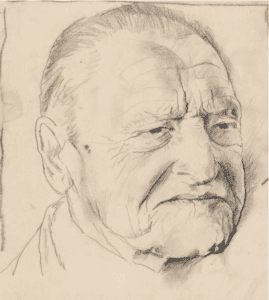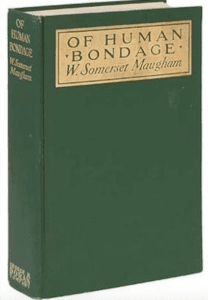JMS Pearce
Hull, England
 |
| Fig 1. Somerset Maugham by Graham Sutherland, black chalk, pencil and gouache, 1953. NPG 5327 |
I have two professions, not one. Medicine is my lawful wife and literature is my mistress; when I get tired of one I spend the night with the other.
-Anton Chekov, 1888
As a graduate who abandoned medicine in favor of writing and other careers ranging from poetry to piracy, Somerset Maugham (1874–1965) (Fig 1) is an example of what Lord Moynihan1 termed “Medical Truants.” Perhaps the first was the Egyptian Imhotep, a physician, sage, and the greatest architect designer of the step pyramid of Sakkarah. Maugham followed a long list of literary medical men: René Laennec, François Rabelais, Thomas Browne, John Arbuthnot, Tobias Smollett, John Keats, Robert Bridges, Anton Chekov, Oliver Wendell Holmes, Warwick Deeping, A. J. Cronin, Francis Brett Young, Arthur Conan Doyle, and many others vividly portrayed in miniature by TK Monro.2
Somerset Maugham became famous for his many novels, short stories, travel books, and plays.3 Several were transformed into films. Many of his works were highly praised: the novels Of Human Bondage, Cakes and Ale, The Razor’s Edge, and The Moon and Sixpence; short stories such as “Rain” and “The Outstation”; and his plays Lady Frederick and The Letter. George Orwell, that bastion of plain prose, cited Somerset Maugham as “the writer who has influenced me the most, whom I admire immensely for his power of telling a story.”4 Other admirers were Evelyn Waugh and Ian Fleming.
His books were popular, his sales and consequent prosperity considerable. But he was not without his critics. Lytton Strachey categorized him as “Class Two, Division One” and other critics thought him unimaginative or superficial. His clarity of writing, which he ascribed to his medical training, and his fine storytelling were undervalued. He countered these criticisms in The Summing Up: “but if richness needs gifts with which everyone is not endowed, simplicity by no means comes by nature. To achieve it needs rigid discipline.”
 |
| Fig 2. Somerset Maugham and his world |
Maugham’s unfortunate beginnings (mirrored in Of Human Bondage) were perhaps ingrained in his capricious personality. His early years were in Paris, where his father was a lawyer to the British Embassy.5 Both parents died before he was ten, and he was raised by his starchy uncle Henry, vicar of Whitstable in Kent. He stammered throughout his life. At King’s School, Canterbury he was unhappy; he refused to follow the path of his father and grandfather, who were eminent lawyers. On 27 September 1892, he enrolled at St. Thomas’s Hospital but at the same time began to write. He qualified MRCS, LRCP but never practiced medicine.
The influence of his medical training, however, peeps through in many of his insights into human nature and psychology, evident in his stories. He later recalled the value of his medical experience: “I saw how men died. I saw how they bore pain. I saw what hope looked like, fear and relief . . .” He shunned sentimentality, believing the study of science “freed him from much wishful thinking and sham idealism . . . for it teaches how little things matter and how unimportant was life without its troubles.”6
His first novel Liza of Lambeth (1897) was so successful that he gave up medicine to write full-time. His writing became prolific and lucrative. By the outbreak of the First World War, ten of his plays had been produced and ten novels published, many with acclaim. In the war he served in France with the British Red Cross ambulances and met Frederick Gerald Haxton, who became his companion and lover until Haxton died in 1944.7 Because Haxton was banned from Britain as an “undesirable alien,” they lived at the sumptuous Villa Mauresque in Cap Ferat.
In 1917,a he married Syrie Wellcome, née Barnardo (whom he later vilified) and they had a daughter, Mary Elizabeth (“Liza”), later Baroness Glendevon. After twelve years he left Syrie and moved to the Villa Mauresque to live with Haxton.8 After Haxton’s death in 1944, he lived with Alan Searle.
In 1915 he published Of Human Bondage, badly reviewed at first, but later regarded as a masterpiece containing semi-autobiographical material, although Maugham wrote in 1938: “Fact and fiction are so intermingled in my work that now, looking back on it, I can hardly distinguish one from the other.”
Of Human Bondage portrays Philip Carey who, like Maugham, was an orphan raised by a pious uncle. The embarrassment of Philip’s clubfoot perhaps reflects that of Maugham’s stutter. The Moon and Sixpence is about Paul Gauguin. Cakes and Ale is a satire on the literary world, a cynical picture of lust, containing thinly veiled and unflattering reflections of Thomas Hardy and Hugh Walpole. The Razor’s Edge is a 1944 novel of a disillusioned survivor of the First World War who abandons materialism to seek transcendental meaning through Indian mysticism.
 |
| Fig 3. A Writer’s Notebook |
Maugham did not confine himself to fiction. He was an avid reader of philosophy and classics and he acquired a highly valued collection of art from which he derived both pleasure and insights. His 1967 A Writer’s Notebook (Fig 3) interestingly records his collected ideas, encounters, and private experiences of people, events, and places as sources for future writing.
In both world wars he worked for Secret Intelligence Services (MI6 and the CIA). This led to his creation of Ashenden, a shady character in many of his short stories. Throughout his life5 he traveled widely in the Pacific and Asia, seeking characters and backgrounds for his tales.
Maugham, the master storyteller, was at times cruel and vindictive,9 a complex character with many conflicting aspects. He displayed an image of urbane self-deprecation, a cynical, observant student of human nature who always appeared detached. This plainly shows in the fascinating Somerset Maugham interview with Alan Pryce-Jones [September 1965] recorded on YouTube.
In old age he was often wretched, miserable, waspish, and embittered.b He remained devoted to memories of his mother but was continually troubled by his homosexuality. He burned many letters and papers, sold much of his art collection through Sotheby’s, and had serious financial rows with his daughter, whom he disowned.
His life was burdened by unhappiness, a lonely craving for affection for which his writings served as a catharsis.10 For Maugham, every single fantasy is the fulfillment of a wish, a correction of unsatisfying reality. In his own life he sought a “self-realization tempered by a useless sense of irony: making the best of a bad job.”
Even as a student, Maugham was never keen on a medical career: his aim was always to be a writer.11 Medicine did, however, expose him to what he most wanted for his writing: life in the raw. In The Summing Up he wrote: “I do not know a better training for a writer than to spend some time in the medical profession.” Interestingly, he kept his name on the medical register until his death, aged ninety-one.
He was appointed a Companion of Honour in 1954; Commander of the Legion of Honour; Hon. DLitt: Oxford, Toulouse. With the wealth his books had yielded he set up the Somerset Maugham Award, for the best young British writers, and bequeathed his royalties to the Royal Literary Fund.
Notes
- Various biographers give different dates.
- Several biographers said he had senile dementia, but this is certainly not apparent in the Alan Pryce-Jones interview in his last year of life.
References
- Moynihan Lord Berkeley. Truants, The story of some who deserted Medicine yet triumphed. Cambridge University Press 1936.
- Monro TK. The Physician as Man of Letters, Science and Action. 2nd ed’n. Baltimore, Williams & Wilkins Co., 1951.
- Van Doren C, Van Doren M. W. Somerset Maugham: Novelist, Essayist, Dramatist. Ed. Charles Hanson Towne et al., New York: George H. Doran Company, 1927.
- Orwell G. My Country Right or Left: 1940–43. London: Secker & Warburg. 1968.
- Raphael F. Somerset Maugham, and his world. London, Thames and Hudson. 1976.
- Cordell R. Somerset Maugham: A Biographical and Critical Study London: Heinemann, 1961.
- Calder R. Willie: The Life of W. Somerset Maugham London: Heinemann, 1989.
- Maugham Robin. Somerset and all the Maughams. London: Longmans, Heinemann, 1966.
- Hastings Selina. The Secret Lives Of Somerset Maugham. London, John Murray, 2009.
- Linares F S. (1992) W. Somerset Maugham and a philosophy of life, Durham theses, Durham University. Available at Durham E-Theses Online: http://etheses.dur.ac.uk/5735/.
- O’Mahony S. W Somerset Maugham (1874–1965) and St Thomas’s Hospital: Medical School and the making of a writer. Journal of Medical Biography. 2014;22(1):53-57.
JMS PEARCE is a retired neurologist and author with a particular interest in the history of science and medicine.
Spring 2021 | Sections | Literary Essays

Leave a Reply